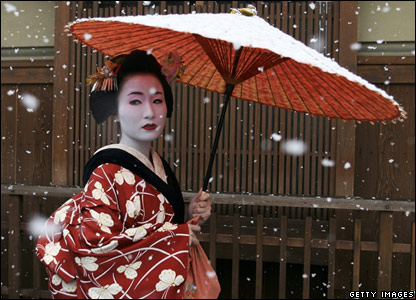Geisha, between the Worlds.
When you hear the word, Geisha, does your mind flash to a white face, red lipped women wearing elaborate silk kimonos? Does the film ‘Memoirs of a Geisha’ come to the forefront of your mind? That classic tale invoking images of controlled love, passionate art and cruel fate all revolving around one artisan’s life. As with any powerful archetype, trying to get to the root of it can be a confusing process at best, a frustrating one at worst.
As a western child of Japan, I can offer a personal reflection which might prove to be the essential element needed in navigating these waters.
Love, it’s a start.
Let’s start with the universal principle of love, idealized in the West – yet seen as a x-factor in the East. As an overwhelming and uncontrollable emotion, love usually does not play in to the relationship of married couples. An acceptable expression of love is for a courtesan or Geisha. Most recorded romances in Japan don’t end happily, many end in Shinju (lovers double suicide).
Tradition, and Tales of the past.
In classical Japanese thought the Western concept of sin does not exist as we know it. To the Japanese such things are primal, yet undeniable urges that must be expressed to be controlled. Sex and violence are a few examples ‘of primal urges.’ In dealing with sex, the Japanese established licensed and taxed pleasure (Red Light) districts in every large city.
These pleasure districts were the homes to tea houses, where sexual encounters were one of many services offered. The pleasure districts were a place where Samurai (Japanese Warriors) could go and enjoy the company of their chosen companions ,men and women, in a cultured atmosphere without the threat of violence, letting them relax surrounded by a world of living art, tranquility manifest.
In the protected enclosures of the pleasure quarter, tea houses were the haunts of Geishas and Samurais. To ensure peace of all who entered, the pleasure district had to leave their weapons with the guards at the entrance.
Elegant and beautiful girls under the age of 10 were sold to the tea houses to become waitresses and courtesans. These girls were not allowed out of the pleasure districts without a written pass from their contract holder – the tea house.
Contract, a hold on life or a new beginning?
Contracts for waitresses and courtesans expires upon the age of 35. A standard Geisha contact lasts for 25 years when she can retire to teach future generations of Geisha or open her own Tea House.
A girl that shows promise as bright and talented individual might convince the tea house to sponsor her training in the artistic skills needed to become a Geisha ‘Art People.’
These girls come from every walk of life, a peasant who was sold during a period of hardship, or the daughter of a poor gambler who staked her at a game of dice. A noble or samurai woman might offer herself up in order to gather resources to maintain her families honor, even if her male relatives objected. This was one of the few freedoms women were allowed in classic Japan.
Freedom could be gained if one’s lover was willing to buy the contract, usually so they could be married. To earn their way out of the life was nearly impossible with 90% of their wages going to the Tea House. It covered their lodging, food, lessons and marvelous silk kimonos. The rest had to be saved, spent on perfumes and personal decor.
The selling of contracts while not uncommon in practice was still fairly unheard of in classic Japan. Geisha contracts fall into two types – the known and the unknown. The ‘unknown’ Geisha contracts were determined by social rank; peasant, commoner, samurai. For those of a ‘known’ Geisha there is no set limit, simply the weight of her reputation.
The Geisha
They were seen as creatures of living art as defined by the word ‘Geisha‘ meaning ‘Art People’ in perfect translation. The foremost role of a Geisha is that of an entertainer ‘Geinin’. Geisha specialize in entertaining their powerful clients at banquets with ritual dancing, singing, and conversation. Playing host to numerous clients, Geisha always have a few careful chosen favorites they call ‘Patrons’.
The patrons usually are the powers-that-be of their day and are extremely wealthy as they bear the cost of the Geisha’s marvelous kimonos and their lessons in the fine arts.
Prostitution is not part of the role of a Geisha. Geishas may be hired by a courtesan to entertain her and her client.
Geishas have the freedom to be intimate with her patrons for it is a private matter not to be judged by society.
Origins, the birth of a Geisha.
The Geisha as we know them came into being during the late Tokugawa Era, when the government in a large crack down on the out of control samurai of the time started creating pleasure districts and licensing tea houses in large cities.
If you are adventurous and which to meet creatures of living art I suggest you to the modern day ‘Pleasure Districts’ of Japan.
Tokyo – Yoshiwana
Kyoto – Shimabara, Gion
A noon-time nap in Kyoto is as educational as a university in the country. – Japanese Proverb

